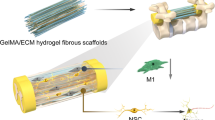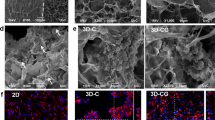Abstract
While many types of biomaterials have been evaluated in experimental spinal cord injury (SCI) research, little is known about the time-related dynamics of the tissue infiltration of these scaffolds. We analyzed the ingrowth of connective tissue, axons and blood vessels inside the superporous poly (2-hydroxyethyl methacrylate) hydrogel with oriented pores. The hydrogels, either plain or seeded with mesenchymal stem cells (MSCs), were implanted in spinal cord transection at the level of Th8. The animals were sacrificed at days 2, 7, 14, 28, 49 and 6 months after SCI and histologically evaluated. We found that within the first week, the hydrogels were already infiltrated with connective tissue and blood vessels, which remained stable for the next 6 weeks. Axons slowly and gradually infiltrated the hydrogel within the first month, after which the numbers became stable. Six months after SCI we observed rare axons crossing the hydrogel bridge and infiltrating the caudal stump. There was no difference in the tissue infiltration between the plain hydrogels and those seeded with MSCs. We conclude that while connective tissue and blood vessels quickly infiltrate the scaffold within the first week, axons show a rather gradual infiltration over the first month, and this is not facilitated by the presence of MSCs inside the hydrogel pores. Further research which is focused on the permissive micro-environment of the hydrogel scaffold is needed, to promote continuous and long-lasting tissue regeneration across the spinal cord lesion.






Similar content being viewed by others
References
Geller HM, Fawcett JW. Building a bridge: engineering spinal cord repair. Exp Neurol. 2002;174:125–36. https://doi.org/10.1006/exnr.2002.7865.
Hejčl AJ, Sameš P, Syková M. Experimental treatment of spinal cord injuries. Cesk Slov Neurol N. 2015;78/111:377–93.
Hejcl A, Sedy J, Kapcalova M, Toro DA, Amemori T, Lesny P, et al. HPMA-RGD hydrogels seeded with mesenchymal stem cells improve functional outcome in chronic spinal cord injury. Stem Cells Dev. 2010;19:1535–46. https://doi.org/10.1089/scd.2009.0378.
Hejcl A, Ruzicka J, Kapcalova M, Turnovcova K, Krumbholcova E, Pradny M, et al. Adjusting the chemical and physical properties of hydrogels leads to improved stem cell survival and tissue ingrowth in spinal cord injury reconstruction: a comparative study of four methacrylate hydrogels. Stem Cells Dev. 2013;22:2794–805. https://doi.org/10.1089/scd.2012.0616.
Nomura H, Baladie B, Katayama Y, Morshead CM, Shoichet MS, Tator CH. Delayed implantation of intramedullary chitosan channels containing nerve grafts promotes extensive axonal regeneration after spinal cord injury. Neurosurgery. 2008;63:127–41. https://doi.org/10.1227/01.NEU.0000335080.47352.31.
Kubinova S, Horak D, Hejcl A, Plichta Z, Kotek J, Proks V, et al. SIKVAV-modified highly superporous PHEMA scaffolds with oriented pores for spinal cord injury repair. J Tissue Eng Regen Med. 2015;9:1298–309. https://doi.org/10.1002/term.1694.
Hejcl A, Lesny P, Pradny M, Sedy J, Zamecnik J, Jendelova P, et al. Macroporous hydrogels based on 2-hydroxyethyl methacrylate. Part 6: 3D hydrogels with positive and negative surface charges and polyelectrolyte complexes in spinal cord injury repair. J Mater Sci Mater Med. 2009;20:1571–7. https://doi.org/10.1007/s10856-009-3714-4.
Kubinova S, Horak D, Kozubenko N, Vanecek V, Proks V, Price J, et al. The use of superporous Ac-CGGASIKVAVS-OH-modified PHEMA scaffolds to promote cell adhesion and the differentiation of human fetal neural precursors. Biomaterials. 2010;31:5966–75. https://doi.org/10.1016/j.biomaterials.2010.04.040.
Salek P, Korecka L, Horak D, Petrovsky E, Kovarova J, Metelka R, et al. Immunomagnetic sulfonated hypercrosslinked polystyrene microspheres for electrochemical detection of proteins. J Mater Chem. 2011;21:14783–92. https://doi.org/10.1039/c1jm12475g.
Okabe M, Ikawa M, Kominami K, Nakanishi T, Nishimune Y. ‘Green mice’ as a source of ubiquitous green cells. FEBS Lett. 1997;407:313–9.
Hejcl A, Urdzikova L, Sedy J, Lesny P, Pradny M, Michalek J, et al. Acute and delayed implantation of positively charged 2-hydroxyethyl methacrylate scaffolds in spinal cord injury in the rat. J Neurosurg Spine. 2008;8:67–73. https://doi.org/10.3171/SPI-08/01/067.
Horák D, Hradil H, Lapčíková M, Šlouf M. Superporous poly(2-hydroxyethyl methacrylate) based scaffolds: preparation and characterization. Polymer. 2008;49:2046–54.
Horak D, Kroupova J, Slouf M, Dvorak P. Poly(2-hydroxyethyl methacrylate)-based slabs as a mouse embryonic stem cell support. Biomaterials. 2004;25:5249–60. https://doi.org/10.1016/j.biomaterials.2003.12.031.
Fitch MT, Doller C, Combs CK, Landreth GE, Silver J. Cellular and molecular mechanisms of glial scarring and progressive cavitation: in vivo and in vitro analysis of inflammation-induced secondary injury after CNS trauma. J Neurosci. 1999;19:8182–98.
Ruzicka J, Romanyuk N, Hejcl A, Vetrik M, Hruby M, Cocks G, et al. Treating spinal cord injury in rats with a combination of human fetal neural stem cells and hydrogels modified with serotonin. Acta Neurobiol Exp. 2013;73:102–15.
Hejcl A, Lesny P, Pradny M, Michalek J, Jendelova P, Stulik J, et al. Biocompatible hydrogels in spinal cord injury repair. Physiol Res. 2008;57(Suppl 3):S121–32.
Amr SM, Gouda A, Koptan WT, Galal AA, Abdel-Fattah DS, Rashed LA, et al. Bridging defects in chronic spinal cord injury using peripheral nerve grafts combined with a chitosan-laminin scaffold and enhancing regeneration through them by co-transplantation with bone-marrow-derived mesenchymal stem cells: case series of 14 patients. J Spinal Cord Med. 2014;37:54–71. https://doi.org/10.1179/2045772312Y.0000000069.
Li N, Sarojini H, An J, Wang E. Prosaposin in the secretome of marrow stroma-derived neural progenitor cells protects neural cells from apoptotic death. J Neurochem. 2010;112:1527–38. https://doi.org/10.1111/j.1471-4159.2009.06565.x.
Hao P, Liang Z, Piao H, Ji X, Wang Y, Liu Y, et al. Conditioned medium of human adipose-derived mesenchymal stem cells mediates protection in neurons following glutamate excitotoxicity by regulating energy metabolism and GAP-43 expression. Metab Brain Dis. 2014;29:193–205. https://doi.org/10.1007/s11011-014-9490-y.
Gunther MI, Weidner N, Muller R, Blesch A. Cell-seeded alginate hydrogel scaffolds promote directed linear axonal regeneration in the injured rat spinal cord. Acta Biomater. 2015;27:140–50. https://doi.org/10.1016/j.actbio.2015.09.001.
Oliveira E, Assuncao-Silva RC, Ziv-Polat O, Gomes ED, Teixeira FG, Silva NA, et al. Influence of different ECM-like hydrogels on neurite outgrowth induced by adipose tissue-derived stem cells. Stem Cells Int. 2017;2017:6319129 https://doi.org/10.1155/2017/6319129.
Papa S, Vismara I, Mariani A, Barilani M, Rimondo S, De Paola M, et al. Mesenchymal stem cells encapsulated into biomimetic hydrogel scaffold gradually release CCL2 chemokine in situ preserving cytoarchitecture and promoting functional recovery in spinal cord injury. J Control Release. 2018;278:49–56. https://doi.org/10.1016/j.jconrel.2018.03.034.
Qu J, Zhang H. Roles of mesenchymal stem cells in spinal cord injury. Stem Cells Int. 2017;2017:5251313 https://doi.org/10.1155/2017/5251313.
Stewart AN, Matyas JJ, Welchko RM, Goldsmith AD, Zeiler SE, Hochgeschwender U, et al. SDF-1 overexpression by mesenchymal stem cells enhances GAP-43-positive axonal growth following spinal cord injury. Restor Neurol Neurosci. 2017;35:395–411. https://doi.org/10.3233/RNN-160678.
Yang EZ, Zhang GW, Xu JG, Chen S, Wang H, Cao LL, et al. Multichannel polymer scaffold seeded with activated Schwann cells and bone mesenchymal stem cells improves axonal regeneration and functional recovery after rat spinal cord injury. Acta Pharmacol Sin. 2017;38:623–37. https://doi.org/10.1038/aps.2017.11.
Tashiro K, Sephel GC, Weeks B, Sasaki M, Martin GR, Kleinman HK, et al. A synthetic peptide containing the IKVAV sequence from the A chain of laminin mediates cell attachment, migration, and neurite outgrowth. J Biol Chem. 1989;264:16174–82.
Tysseling-Mattiace VM, Sahni V, Niece KL, Birch D, Czeisler C, Fehlings MG, et al. Self-assembling nanofibers inhibit glial scar formation and promote axon elongation after spinal cord injury. J Neurosci. 2008;28:3814–23. https://doi.org/10.1523/JNEUROSCI.0143-08.2008.
Tysseling VM, Sahni V, Pashuck ET, Birch D, Hebert A, Czeisler C, et al. Self-assembling peptide amphiphile promotes plasticity of serotonergic fibers following spinal cord injury. J Neurosci Res. 2010;88:3161–70. https://doi.org/10.1002/jnr.22472.
Andrews MR, Czvitkovich S, Dassie E, Vogelaar CF, Faissner A, Blits B, et al. Alpha9 integrin promotes neurite outgrowth on tenascin-C and enhances sensory axon regeneration. J Neurosci. 2009;29:5546–57. https://doi.org/10.1523/JNEUROSCI.0759-09.2009.
Cheah M, Andrews MR, Chew DJ, Moloney EB, Verhaagen J, Fassler R, et al. Expression of an activated integrin promotes long-distance sensory axon regeneration in the spinal cord. J Neurosci. 2016;36:7283–97. https://doi.org/10.1523/JNEUROSCI.0901-16.2016.
Deumens R, Koopmans GC, Honig WM, Hamers FP, Maquet V, Jerome R, et al. Olfactory ensheathing cells, olfactory nerve fibroblasts and biomatrices to promote long-distance axon regrowth and functional recovery in the dorsally hemisected adult rat spinal cord. Exp Neurol. 2006;200:89–103. https://doi.org/10.1016/j.expneurol.2006.01.030.
Deumens R, Koopmans GC, Honig WM, Maquet V, Jerome R, Steinbusch HW, et al. Limitations in transplantation of astroglia-biomatrix bridges to stimulate corticospinal axon regrowth across large spinal lesion gaps. Neurosci Lett. 2006;400:208–12. https://doi.org/10.1016/j.neulet.2006.02.050.
Deng LX, Deng P, Ruan Y, Xu ZC, Liu NK, Wen X, et al. A novel growth-promoting pathway formed by GDNF-overexpressing Schwann cells promotes propriospinal axonal regeneration, synapse formation, and partial recovery of function after spinal cord injury. J Neurosci. 2013;33:5655–67. https://doi.org/10.1523/JNEUROSCI.2973-12.2013.
Iida T, Nakagawa M, Asano T, Fukushima C, Tachi K. Free vascularized lateral femoral cutaneous nerve graft with anterolateral thigh flap for reconstruction of facial nerve defects. J Reconstr Microsurg. 2006;22:343–8. https://doi.org/10.1055/s-2006-946711.
Glaser J, Gonzalez R, Sadr E, Keirstead HS. Neutralization of the chemokine CXCL10 reduces apoptosis and increases axon sprouting after spinal cord injury. J Neurosci Res. 2006;84:724–34. https://doi.org/10.1002/jnr.20982.
Gao XR, Xu HJ, Wang LF, Liu CB, Yu F. Mesenchymal stem cell transplantation carried in SVVYGLR modified self-assembling peptide promoted cardiac repair and angiogenesis after myocardial infarction. Biochem Biophys Res Commun. 2017;491:112–8. https://doi.org/10.1016/j.bbrc.2017.07.056.
Hou Y, Ryu CH, Jun JA, Kim SM, Jeong CH, Jeun SS. IL-8 enhances the angiogenic potential of human bone marrow mesenchymal stem cells by increasing vascular endothelial growth factor. Cell Biol Int. 2014;38:1050–9. https://doi.org/10.1002/cbin.10294.
Wang C, Poon S, Murali S, Koo CY, Bell TJ, Hinkley SF, et al. Engineering a vascular endothelial growth factor 165-binding heparan sulfate for vascular therapy. Biomaterials. 2014;35:6776–86. https://doi.org/10.1016/j.biomaterials.2014.04.084.
Golebiewska EM, Poole AW. Platelet secretion: from haemostasis to wound healing and beyond. Blood Rev. 2015;29:153–62. https://doi.org/10.1016/j.blre.2014.10.003.
Ullm S, Kruger A, Tondera C, Gebauer TP, Neffe AT, Lendlein A, et al. Biocompatibility and inflammatory response in vitro and in vivo to gelatin-based biomaterials with tailorable elastic properties. Biomaterials. 2014;35:9755–66. https://doi.org/10.1016/j.biomaterials.2014.08.023.
Feng Y, Li Q, Wu D, Niu Y, Yang C, Dong L, et al. A macrophage-activating, injectable hydrogel to sequester endogenous growth factors for in situ angiogenesis. Biomaterials. 2017;134:128–42. https://doi.org/10.1016/j.biomaterials.2017.04.042.
Acknowledgements
We would like to thank Frances Zatřepálková and Jan Lodin for proofreading the manuscript. The study has been supported by 2 grants from the Grant Agency of the Czech Republic 14-14961S, 17-11140S, the Operational Programme Research, Development and Education in the framework of the project “Centre of Reconstructive Neuroscience “, registration number CZ.02.1.01/0.0./0.0/15_003/0000419 and by the grant from the Ministry of Education, Youth and Sports No. LO1309.
Author information
Authors and Affiliations
Corresponding author
Ethics declarations
Conflict of interest
The authors declare that they have no conflict of interest.
Rights and permissions
About this article
Cite this article
Hejčl, A., Růžička, J., Proks, V. et al. Dynamics of tissue ingrowth in SIKVAV-modified highly superporous PHEMA scaffolds with oriented pores after bridging a spinal cord transection. J Mater Sci: Mater Med 29, 89 (2018). https://doi.org/10.1007/s10856-018-6100-2
Received:
Accepted:
Published:
DOI: https://doi.org/10.1007/s10856-018-6100-2




